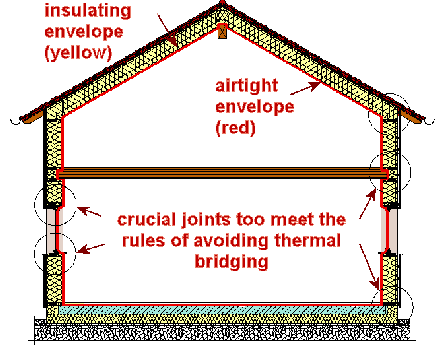| |
Insulation |
|
|
The most important principle of a Passive House: insulation (yellow), applied continuously around the building envelope without thermal bridging - this reduces the heat losses like a warm coat. Most insulation materials are not airtight, however. Therefore the envelope has to be airtight, too. The airtight envelope can be seen in the section, too - it is given by the red line. The reduction of thermal bridges is very important; A special design method, the "Construction Avoiding Thermal Bridging" has been developed to simplify this design detail.
|
| In a Passive Home the whole building envelope
has an excellent thermal insulation. The envelope consists of all
parts of the construction, which separate the indoor climate from
the outdoor climate. All construction methods can be used for Passive
Houses and have been tested successfully: masonry construction,
lightweight construction, prefabricated elements, insulating concrete
formwork construction, steel construction, and all combinations
of the methods above. 11th International Conference on Passive Houses: Experience with insulation, air tightness, and innovative methods for the building envelope will be discussed in the Workshop "Reserach and Development". Insulation is efficient for energy conservation, increasing thermal comfort in existing buildings, too. This will be shown by retrofit examples in Workshops on using Passive House components for refurbishment. Top products of insulating components will be presented in the exhibition - some with models of original size.
(updated:
2006-09-23 thanks
to Dylan Lamar for proof reading |
